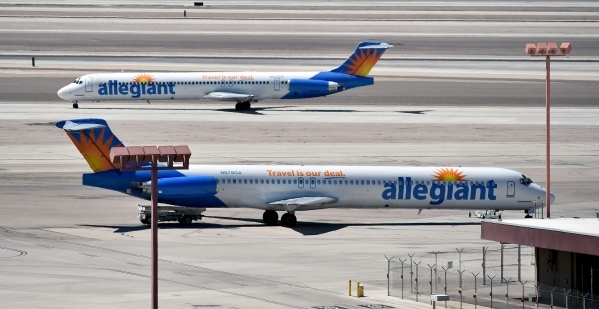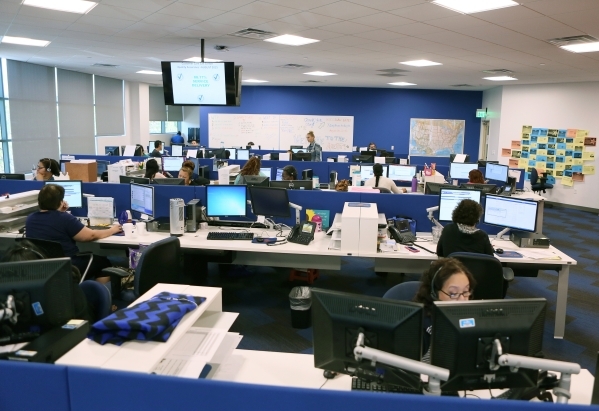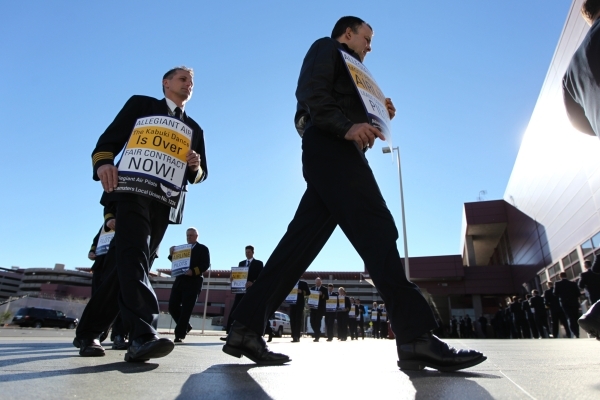Unusual incidents rock Allegiant Air’s profitable course
It's no secret why Allegiant Air is the most profitable airline in the sky.
The Las Vegas-based airline operated by Allegiant Travel Co. has a successful business model built around flying residents of small-town America to the leisure destinations they love.
And, in 90 percent of the cities the airline flies, it's the only game in town. To the Bozemans, Minots and Laredos of the world, Allegiant provides affordable jet passenger service to places such as Orlando, Phoenix and Las Vegas.
Allegiant's biggest competition is the living-room couch.
It's also no secret that Allegiant maintains a high profit margin with low operational costs, including using aircraft that are considered old by industry standards but still have thousands of operational hours ahead of them.
But a recent rash of emergency landings and unusual flight incidents have put Allegiant in the spotlight and have left many observers asking if the company's old fleet has worn out its welcome.
Since the beginning of 2015, there have been 16 reported incidents involving Allegiant flights that resulted in emergency landings, flight diversions, aborted takeoffs or, maybe the most bizarre of all, a passenger-initiated evacuation.
The most serious incident occurred in Las Vegas on Aug. 17 when the nose of a twin-engine MD-80 jet on its takeoff roll began rising prematurely, defying the flight crew's attempts to keep it down. When the plane reached 138 mph, the pilot aborted the takeoff, bringing the jet to a halt, according to a report filed with the Federal Aviation Administration.
A preliminary FAA investigation found that a nut on a component that moves the left elevator had fallen off, causing the control surface to become jammed in the up position. A similar circumstance led to the crash of an Alaska Airlines MD-80 over the Pacific Ocean on Jan. 31, 2000.
A ROUGH SUMMER
It's been a rough summer for Allegiant:
• On Monday, an Allegiant Boeing 757 bound for Las Vegas from Austin, Texas, aborted a takeoff after an engine indicator light came on. The crew reported a medical emergency for a woman suffering a panic attack and seven of the aircraft's eight tires blew as a result of the stop, according to an account in the Aviation Herald.
• On Aug. 3, the crew of an MD-80 jet flying from St. Petersburg, Fla., to Richmond, Va., performed a precautionary shutdown of an engine inflight and landed safely in Greensboro, N.C.
• On Aug. 1, the pilot of a Boeing 757 taking off from McCarran for Fresno, Calif., declared an emergency and returned to Las Vegas after a reported compressor stall. The engine was operating with reduced thrust, but passengers reported flames coming from the affected engine. The plane landed without incident.
• On July 20, an Allegiant MD-80 crew flying from Fort Lauderdale, Fla., to Memphis, Tenn., reported smoke in the cabin and diverted to Orlando's Sanford International Airport. The plane landed safely.
• On July 3, the crew of an MD-80 flying from Ashville, N.C., to Punta Gorda, Fla., requested to land in Sarasota, then opted to divert to St. Petersburg, Fla. The crew determined it was a faulty sensor reading.
• On June 25, an MD-80 flight from St. Petersburg to Niagara Falls, N.Y., diverted to Orlando Sanford Airport after a sensor problem. It turned out there was a wasp in the sensor.
• On June 18, an Allegiant Airbus A320 flying from St. Petersburg to Pittsburgh returned to the St. Petersburg airport because the plane wasn't pressurizing properly.
• On June 12, an Allegiant MD-80 flight from Las Vegas to Moline, Ill., returned to Las Vegas after an engine warning light lit up.
THE FARGO INCIDENT
Then, there was the incident that may be been Allegiant's most embarrassing. An MD-80 flight from Las Vegas to Fargo, N.D., left McCarran late because of an onboard medical emergency. But by the time the flight reached the airspace near Fargo, the crew learned that the airport was closed because of a practice by the Navy's Blue Angels precision flight team. The closure was listed on FAA notices to airmen, but the crew and the ground dispatch team apparently didn't note it. By the time the flight was getting close to Fargo, the plane was getting close to dipping into its 45 minutes of reserve fuel.
The crew declared an emergency and landed at Fargo and in subsequent disclosures by the airline, it was determined that Allegiant's vice president of operations and the director of flight safety, government affairs and quality assurance, were at the controls.
The FAA still has open investigations on the Fargo incident and Aug. 17's aborted takeoff in Las Vegas.
Another incident under scrutiny was a passenger-initiated evacuation of a plane in Boise, Idaho, on June 12. The flight had arrived at Boise Airport from Los Angeles and passengers were waiting to be deplaned. Ground crews hadn't yet hooked up the air conditioning and it was getting hot and stuffy inside the plane.
Passengers then reported smelling jet fuel from the back of the plane. Once the air conditioning came on, condensation came through the air vents. Passengers panicked and those sitting in the emergency exits took the initiative of popping open the doors over the wing without instruction from the flight crew. Before long, passengers emerged onto the wing, some with carry-on luggage in hand.
Are Allegiant planes dangerous because of their age? MD-80s were manufactured from 1979 to 1999. Are passengers so jittery in perceiving danger that they would bail out to the wing of a plane?
STRANGE INCIDENT
Allegiant Chief Operating Officer Steve Harfst didn't have anything to say about the Boise evacuation, which he admitted was one of the strangest things he had ever seen in his aviation career.
But he's also extremely confident that Allegiant's fleet is safe and that it's maintained as well as any airline in the country.
"Safety is our No. 1 priority," Harfst said in a recent memorandum to all Allegiant employees.
"Nothing trumps safety. Not schedule, not profits, not on-time performance. Nothing," he said. "This is the most bedrock principle of our profession, our industry, our company, our operations group and of every flight we push."
Although the most ardent critics lay the blame of the recent spate of incidents on the aging fleet, aviation experts concur that age has nothing to do with it.
"An airplane that just came out of the factory can be 'old' if it's not maintained properly," said Mike Boyd, an Evergreen, Colo.-based aviation consultant who is conducting an aviation forecast summit in Las Vegas this week.
"Age is almost a meaningless number," Boyd said. "If we all took care of our cars like they (Allegiant) take care of their airplanes, we'd all be driving around in '56 Oldsmobiles."
The main reason Allegiant flies older aircraft is because they can be acquired at a fraction of what new planes cost. Allegiant can get a used MD-80 for $3.5 million to $5 million while a new Airbus A320 costs about $60 million.
Allegiant owns all of its planes so there's no financing costs associated with the fleet.
"It's just like a consumer buying a car," Harfst said in a recent interview. "You evaluate how much it will cost you over time for a new one, but when it comes down to it, you may be better off with a used car that you can pay off immediately and still get lots of use if you keep up on the maintenance."
Harfst said using older planes keeps costs low and because Allegiant's fleet use is so much different from most airlines, it makes sense for the company.
LOW FREQUENCIES
"We don't focus too much on how much life (a plane) has left because aircraft can fly for quite awhile. Because we fly such low frequencies, such low utilization, it's kind of like changing the oil on your car every 3,000 miles.
"Because we put such low hours and cycles on our aircraft on a daily basis, the aircraft might be aged, but we're not using the aircraft to the extent that another airline would do that's flying 13 hours a day, every day, six to eight cycles a day. We maybe do two or three cycles a day and only fly a couple of hours. Tuesdays and Wednesdays, much of the fleet is parked," he said.
That's because of Allegiant's unusual business model of low frequencies.
The company will only fly a route twice or three times a week while airlines such as Frontier and Spirit, which have similar ticket pricing structures, fly a destination two or three times a day.
"It's a bit of a misnomer when you try to look at the age of the aircraft," he said. "What we really focus on are the cycles, the amount of flights the aircraft does. That's what drives the scheduled maintenance events for an aircraft. Because we fly so infrequently compared to what the aircraft was really designed to do, we tend to hit those calendar limits long before we hit the cycle limit that would require maintenance to be done. While the aircraft itself might be old in years, the actual use of that aircraft is much less."
Most routine maintenance is conducted by Allegiant's own mechanics. The company has 80 — most with at least nine years of seniority with the company and more than 18 years of experience — based in Las Vegas.
When it comes to major maintenance, Allegiant, like most airlines, sends its aircraft to specialized bases in Indianapolis and Oklahoma City.
One of the unique aspects to Allegiant's business model is that every flight is an out-and-back operation. That means crew members have the luxury of spending the night in their own homes every night if they operate from their home base. They'll work a flight from Las Vegas to Fargo, for example, and then fly the return back to Las Vegas.
With that type of model in place, it's also why Allegiant does everything it can to land planes in established maintenance bases. A mechanic and a spare part is available in Las Vegas — but it usually isn't in Fargo, where the airline must work with contracted mechanics and fly in necessary parts.
TEAMSTER CRITICS
Some of Allegiant's biggest critics come from a group that has become close to the company in the past three years — the Teamsters union.
Allegiant pilots elected representation by the International Brotherhood of Teamsters in August 2012 and the union and management have been working to hammer out its first contract since then.
Throughout the process, the union has taken every opportunity to point out maintenance issues in an apparent bid to embarrass the company into caving in negotiations.
The Teamsters commissioned a report by the Teamsters Aviation Mechanics Coalition that was not conducted by Allegiant mechanics, who are not represented by the union. The company says the report was written without a mechanic even looking at an Allegiant plane.
The union has publicly claimed that Allegiant pilots have safety concerns — and some have spoken with the media about those issues.
But Allegiant Chairman Maurice Gallagher, who considers the union an unwanted third party to contract negotiations, calls the Teamster tactics "a distraction."
"They are intended to distract our leadership, our pilots and our customers from the real issue at hand: negotiating a contract that is fair to our pilots while ensuring that we can continue to offer our customers the low-fare nonstop service they want."
Would pilots be too vigilant in their decisions about declaring an emergency, just to call attention to perceived maintenance woes?
"I don't believe that for a minute," Harfst said. "I have full faith and confidence in our flight crews."
When labor relations are a factor, the FAA routinely keeps a closer watch on an airline and Allegiant has been no exception. Allegiant's certificate is overseen by the Las Vegas flight standards district office and, like most commercial carriers, Allegiant has almost daily contact with regulators.
FINANCIAL EFFECTS
How have the flight incidents and the union acrimony meant to Allegiant's bottom line?
Not much.
"We've seen no dips in bookings over the summer," Harfst said. "In fact, we've exceeded our forecasts and our bookings have been the strongest in the airline's history. Of course, part of that is our expansion into new markets."
Allegiant has 294 routes, serving 107 U.S. cities with 77 aircraft. By comparison, Southwest Airlines, the busiest carrier at McCarran, serves 95 cities and has 679 aircraft.
In 2014, Allegiant Travel reported adjusted net income of $113.3 million, $6.37 a share, on revenue of $1.14 billion. Earnings per share that year were 32.2 percent ahead of 2013 and the company reported return on capital of 19.2 percent.
Harfst said Allegiant has a long-term plan to convert the airline to an all-Airbus fleet, not so much because the jets would be newer but because they'd be more fuel efficient, more economical to operate and will have greater capacity and thus, more profitable to fly.
Allegiant just announced the planned acquisition of its 50th Airbus A320-model aircraft (its A319s are considered a part of that fleet). By 2018, Harfst said most of Allegiant's jets will be Airbuses with 56 of 100 in the mix. The company gradually plans to retire the MD-80 jets, but that will take several years to accomplish.
When that happens, critics won't have the old MD-80s to kick around anymore — but by then, some of the "new" Airbus planes may almost be as old as the MD-80s are to the company now.
Contact reporter Richard N. Velotta at rvelotta@reviewjournal.com or 702-477-3893. Find @RickVelotta on Twitter.






















